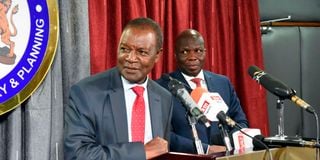Premium
Ruto to shelve Sh182bn Uhuru-era programmes

National Treasury Cabinet Secretary Njuguna Ndung’u with Economic Planning Principal Secretary James Muhati during a media briefing on December 6.
President William Ruto will shelve Sh182 billion in funding allocated to projects by the Uhuru Kenyatta administration to ease the strain on State coffers and redirect the money to his priority projects.
The National Treasury has revealed in disclosures to the International Monetary Fund (IMF) that the cut will be among fiscal readjustments that will be included in the supplementary budget for the financial year 2022/23 that will be submitted to Parliament by end of January next year.
The move is part of Dr Ruto’s Sh290 billion cut to this year’s Sh3.3 trillion budget targeting non-priority recurrent expenditures such as domestic and foreign travel, training expenses and hospitality expenses, and development expenditures.
“On the spending side, we will contain expenditures at Sh3.386 trillion by partly offsetting existing pressures (Sh290 billion) through cuts on non-priority recurrent spending for Sh48.6 billion and an ambitious plan of rationalisation of non-priority projects for Sh181.6 billion,” said the Treasury.
Also Read: Raila vs Ruto - The case files
It is unclear the projects that have been earmarked for the chop, but Kenya has hundreds of stalled projects that have gone for decades without completion largely due to inadequate funds and misappropriation of allocated funds.
The government last year committed to cancel 437 stalled projects, which the IMF estimated that they need Sh1 trillion to be completed, a capital outlay that the government cannot currently afford.
“The rationalisation of projects mainly reflects the recognition of slow absorption of ongoing projects,” said the Treasury.
Dr Ruto is seeking to offset the Sh279.26 billion additional spending – including arrears from the financial year 2021/22 – that would have further inflated this year’s budget exerting extra strain on the exchequer.
This includes arrears amounting to Sh89 billion from Mr Kenyatta’s last fiscal year in office and Sh61 billion approved under Article 223 of the Constitution.
The section allows the Treasury to withdraw money from the Consolidated Fund without the approval of lawmakers.
The exchequer is, however, required to seek the approval of Members of parliament (MPs) within two months through a supplementary budget.
“Remaining pressures (Sh130 billion) are mainly related to the July and August pause in fuel price adjustments, July’s temporary introduction of a maize flour subsidy, unavoidable drought emergency interventions, and the launch of new initiatives from our administration, including plans to support agricultural production by subsidising fertiliser,” said the Treasury.
Supplementary budget
The supplementary budget will target an overall balance of 5.8 per cent of the gross domestic product (GDP) compared to an outturn of 6.2 per cent of GDP in the financial year 2021/22, it said.
“This significant reduction will reflect both improved prospects to mobilise revenues and our intention to reprioritise expenditures while protecting social spending and recognising existing liquidity constraints due to the persistence of unfavourable market conditions.”
The Treasury is also swapping short-term with longer-term debt to reduce its immediate repayment obligations that have exerted huge pressure on government coffers.
Kenya’s debt servicing costs remain high, and the Treasury will spend Sh1.393 trillion to service both principal and debt interest in the current financial year.
This is an increase from the Sh1.151 trillion spent to service debt in the previous financial year.
Further, the government will this month drop funding for the fuel subsidy that has been key to stabilising fuel prices in anticipation of reduced global crude oil prices for December and January that will organically lower pump prices.
“On the revenue side, we expect tax collection to reach Sh2,035 billion in end-June against a programme target of Sh2,024 billion, supported by robust indirect and custom taxes on account of the pass-through of higher international prices and the somewhat weaker-than-originally anticipated shilling,” added the Treasury.
An austerity plan released in November by the National Treasury showed that the entire budget on foreign travel, training, purchases of furniture, and motor vehicles has been cut, leaving the items the worst hit by President Ruto’s purge on the expenditures of ministries, departments, and agencies (MDAs) in the current financial year.
A schedule by Treasury Cabinet Secretary Njuguna Ndung’u showed that 100 per cent of the remaining balances on foreign travel, training, and motor vehicle and furniture purchase budgets as of September 30, 2022 have been cut.
The Treasury has also effected a 75 per cent cut on the remaining budgets on communication services, domestic travel, advertising and printing, hospitality, and vehicle rentals as of September 30, 2022.
A similar 75 per cent cut has been made on research and feasibility study budgets—underlining the depth of the recurrent expenditure rationalisation programme that is targeted at freeing up cash for other more critical projects such as healthcare, education, and food security.
The Treasury additionally ordered the accounting officers of all MDAs to audit the salary requirements for their staff to curb abuse of funds through avoidable perks such as allowances.





